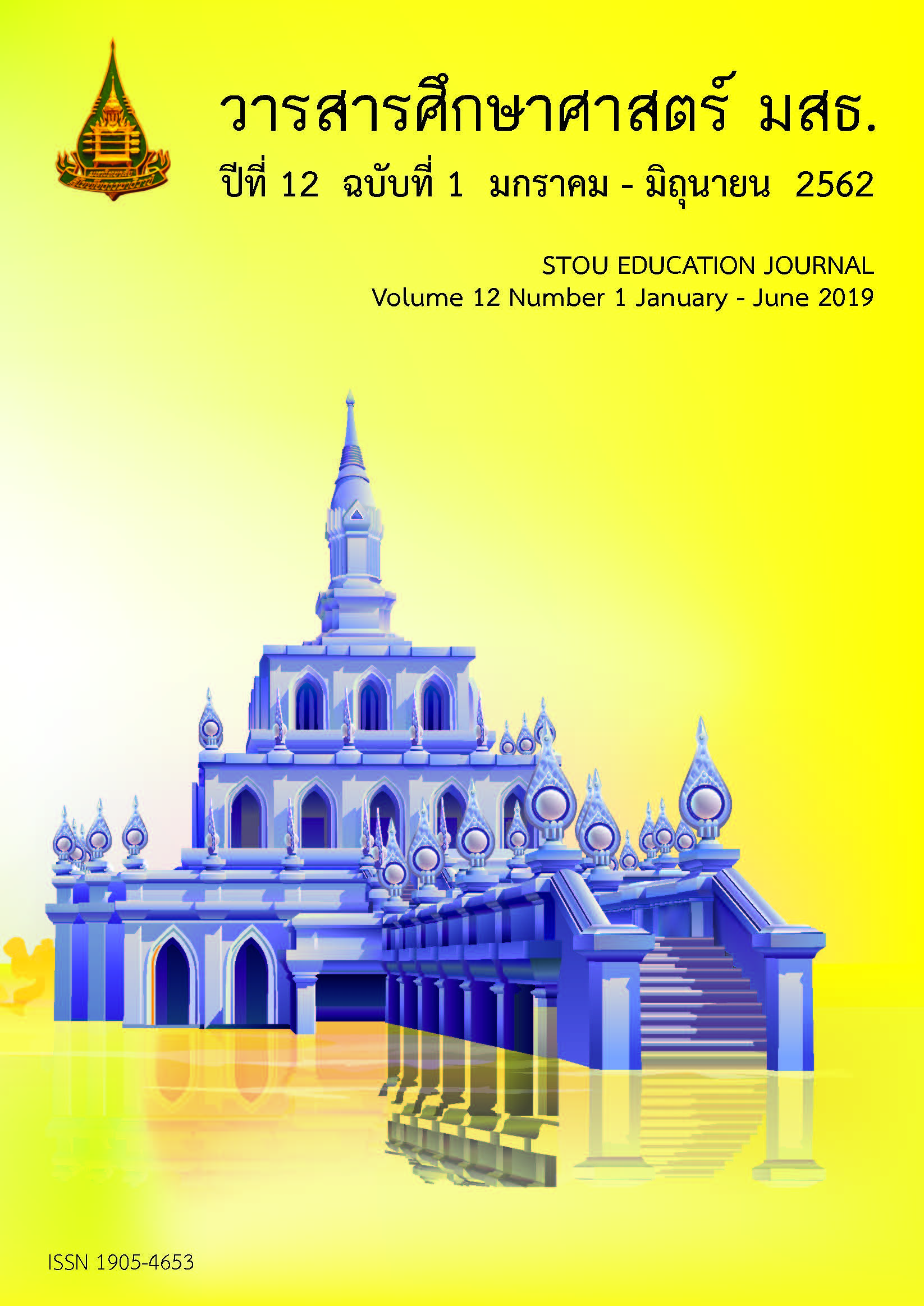Development of Scientific Creative Thinking in the Topic of Biodiversity of Mathayom Suksa 3 Students Learning under the 5E Inquiry Cycle Learning Management together with the 4 MAT Technique
Main Article Content
Abstract
The purpose of research was to develop scientific creative thinking in the topic of Biodiversity of Mathayom Suksa 3 students learning under the 5E inquiry cycle learning management together with the 4 MAT technique. The research sample consisted of 48 Mathayom Suksa 3 students at Thidanukroh School during the second semester of the 2017 academic year, obtained by cluster random sampling. The content of the study was the topic of Biodiversity at Mathayom Suksa 3 level in the Science Learning Area of the Basic Education Core Curriculum, B.E. 2551. This study was conducted during the first semester of the 2017 academic year. The research duration covered 15 periods in three weeks, with three periods per week. The employed research instruments were 1) six learning management plans in the topic of Biodiversity for the 5E inquiry cycle learning management together with the 4 MAT technique: (1) Biodiversity of Plants and Animals in the Local Area, (2) The Plant Kingdom, (3) The Animal Kingdom, (4) The Effects of Biodiversity, (5) Advancement in Biotechnology, and (6) The Benefits of Biodiversity; and 2) a scale to assess scientific creative thinking. Research data were analyzed with the t-test for dependent samples. The research findings revealed that the post-experiment scientific creative thinking mean score of Mathayom Suksa 3 students learning under the 5E inquiry cycle learning management together with the 4 MAT technique was significantly higher than their pre-experiment counterpart mean score at the .05 level of statistical significance.
Article Details
References
กรมวิชาการ. (2536). นวัตกรรมการเรียนการสอนวิทยาศาสตร์ ระดับมัธยมศึกษา. กรุงเทพฯ: โรงพิมพ์คุรุสภาลาดพร้าว.
จิต นวนแก้ว. (2543). การพัฒนาความสามารถด้านการคิดขั้นสูงในวิชาวิทยาศาสตร์ของนักเรียนระดับมัธยมศึกษาปีที่ 1. (วิทยานิพนธ์ปริญญามหาบัณฑิต ไม่ได้ตีพิมพ์) มหาวิทยาลัยศรีนครินทรวิโรฒ, กรุงเทพมหานคร.
จิรดี ประยูรศิริ. (2550). การพัฒนาผลสัมฤทธิ์ทางการเรียนและความคิดสร้างสรรค์ทางคณิตศาสตร์ของนักเรียนระดับประกาศนียบัตรวิชาชีพ สาขาพาณิชยการ วิทยาลัยอาชีวศึกษาฉะเชิงเทรา. (วิทยานิพนธ์ปริญญามหาบัณฑิต ไม่ได้ตีพิมพ์). จุฬาลงกรณ์มหาวิทยาลัย, กรุงเทพมหานคร.
ประเวศ วะสี. (2539). คุยกันเรื่องความคิดกับ ศ.น.พ. ประเวศ วะสี. กรุงเทพฯ: พิมพ์ดี.
พิธุลาวัลย์ ศุภอุทุมพร. (2559). รายงานการวิจัยเรื่อง ผลการใช้รูปแบบวงจรการเรียนรู้ 5 ขั้นตอนที่มีต่อความสามารถในการคิดอย่างมีเหตุผลทางวิทยาศาสตร์ และความสามารถในการคิดสร้างสรรค์ทางวิทยาศาสตร์ของนักเรียนชั้นมัธยมศึกษาตอนต้นในโรงเรียนสาธิตจุฬาลงกรณ์มหาวิทยาลัย ฝ่ายมัธยม. คณะครุศาสตร์ จุฬาลงกรณ์มหาวิทยาลัย.
สถาบันส่งเสริมการสอนวิทยาศาสตร์และเทคโนโลยี. (2546). การศึกษาความสามารถในการใช้ความคิด ขั้นสูงของนักเรียนชั้นมัธยมศึกษาปีที่ 3 ที่เรียนวิชาชีววิทยาในเขตกรุงเทพมหานคร ปีการศึกษา 2543 สาขาชีววิทยา. กรุงเทพฯ: สถาบันส่งเสริมการสอนวิทยาศาสตร์และเทคโนโลยี.
สิทธิชัย จันทร์คลาย. (2550). การเปรียบเทียบความคิดสร้างสรรค์และผลสัมฤทธิ์ทางการเรียนคณิตศาสตร์ เรื่องรูปสี่เหลี่ยม ของนักเรียนชั้นประถมศึกษาปีที่ 6 ที่ได้รับการสอนแบบ4 MAT กับการสอนแบบปกติ. (วิทยานิพนธ์ปริญญามหาบัณฑิต ไม่ได้ตีพิมพ์). มหาวิทยาลัยบูรพา, ชลบุรี.


